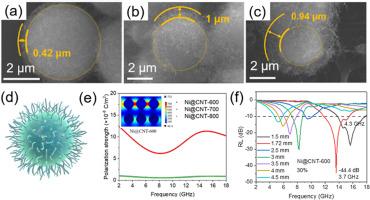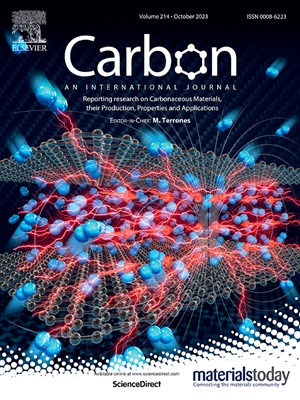在具有可定制微结构的 MOF 衍生 Ni@CNT 上合成原位生长的 CNT,以调节电磁波吸收性能
IF 10.5
2区 材料科学
Q1 CHEMISTRY, PHYSICAL
引用次数: 0
摘要
近年来,金属有机框架(MOF)衍生物已被用作电磁波吸收(EMA)材料。碳纳米管(CNT)可以在 MOF 衍生物表面实现原位生长。然而,通过调节原位生长的 CNT 的形态来提高 EMA 性能的研究还很有限。在这项工作中,我们采用溶解热法和简单的一步热解法制备了长度可控的 MOF 衍生物镍@碳纳米管(Ni@CNT),并揭示了 CNT 的生长机理。我们进一步研究了原位生长的 CNT 形貌对电磁参数和 EMA 性能的影响。在 MOF 衍生物表面原位生长的长度相近的 CNT 具有相似的电磁参数。当 CNT 的长度较短时,弛豫强度(Δε=εs-ε∞)较高,从而获得优异的微波吸收性能。对于 Ni@CNT-600,仅 1.72 mm 的反射损耗就可达到 -44.4 dB。通过计算电场和极化强度,有限元(FE)模拟评估了不同样品的 EMA 机制。该研究从微结构裁剪的角度探讨了电磁波吸收性能,有助于理解原位生长的 CNT 在 MOF 衍生物表面的独特作用,有助于研究超薄电磁波吸收材料。本文章由计算机程序翻译,如有差异,请以英文原文为准。

Synthesis of in situ grown CNTs on MOF-derived Ni@CNT with tailorable microstructures toward regulation of electromagnetic wave absorption performance
Metal-Organic framework (MOF) derivatives have been applied as electromagnetic wave absorption (EMA) materials in recent years. Carbon nanotubes (CNTs) can achieve in situ growth on the surface of MOF derivatives. However, there is limited research on the EMA performance by regulating the morphology of the in situ grown CNTs. In this work, we prepared MOF-derived Ni@carbon nanotubes (Ni@CNT) with controllable length of CNTs by solvothermal and simple one-step pyrolysis method and revealed the CNT growth mechanism. We further investigated the effect of in situ grown CNT morphology on electromagnetic parameters and EMA performance. In situ grown CNTs of similar length on the surface of MOF derivatives lead to similar electromagnetic parameters. When the length of CNTs is short, the relaxation strength () is high, leading to excellent microwave absorption performance. For Ni@CNT-600, the reflection loss of −44.4 dB can be achieved at merely 1.72 mm. Finite element (FE) simulation was used to evaluate the EMA mechanism of different samples by calculating electric field and polarization strength. This work has explored the electromagnetic wave absorption performance from the perspective of microstructural tailoring, helpful for understanding the unique role of the in situ grown CNTs on the surface of MOF derivatives and investigating the ultra-thin electromagnetic wave absorption materials.
求助全文
通过发布文献求助,成功后即可免费获取论文全文。
去求助
来源期刊

Carbon
工程技术-材料科学:综合
CiteScore
20.80
自引率
7.30%
发文量
0
审稿时长
23 days
期刊介绍:
The journal Carbon is an international multidisciplinary forum for communicating scientific advances in the field of carbon materials. It reports new findings related to the formation, structure, properties, behaviors, and technological applications of carbons. Carbons are a broad class of ordered or disordered solid phases composed primarily of elemental carbon, including but not limited to carbon black, carbon fibers and filaments, carbon nanotubes, diamond and diamond-like carbon, fullerenes, glassy carbon, graphite, graphene, graphene-oxide, porous carbons, pyrolytic carbon, and other sp2 and non-sp2 hybridized carbon systems. Carbon is the companion title to the open access journal Carbon Trends. Relevant application areas for carbon materials include biology and medicine, catalysis, electronic, optoelectronic, spintronic, high-frequency, and photonic devices, energy storage and conversion systems, environmental applications and water treatment, smart materials and systems, and structural and thermal applications.
 求助内容:
求助内容: 应助结果提醒方式:
应助结果提醒方式:


